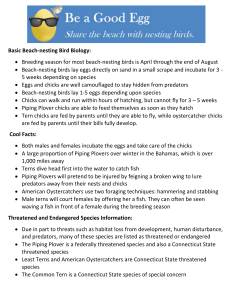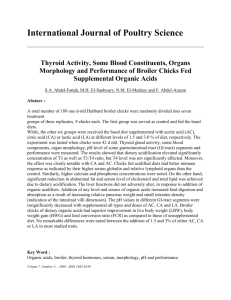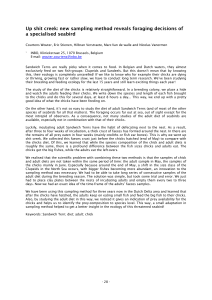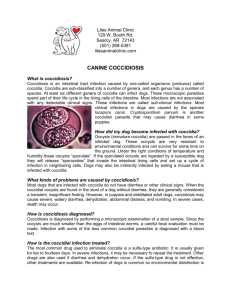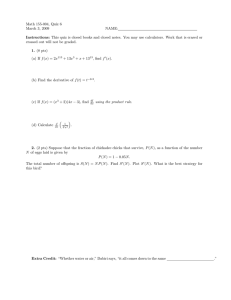Extension Circular 405 Department of Veterinary April E. M. Dickinson
advertisement
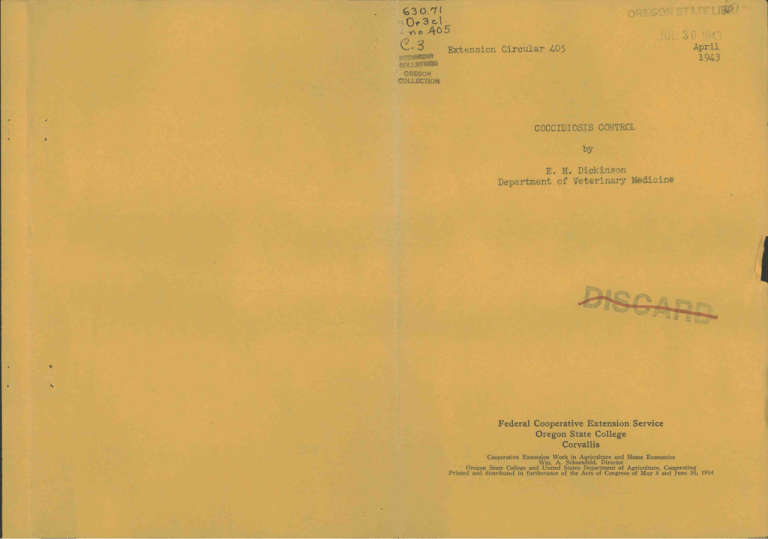
.4O5 L. April Extension Circular 405 1943 O REGO OLLECTC;N COCCIDIOSIS CONTROL by E. M. Dickinson Department of Veterinary Medicine Federal Cooperative Extension Service Oregon State College Corvallis Cooperative Extension Work in Agriculture and Home Economics Vm. A. Schoenfeld, Director Oregon State College and United States Department of Agriculture, Cooperating Printed and distributed in furtherance of the Acts of Congress of May 8 and June 30. 1914 OGCN LMJE LI1JkA4RY I r 3I C.. 3 tension Circular 405 April 1943 COCCIDIOSIS CONTROL by E. M. Dickinson Department of Veterinary Medicine The problem of eoccldiosis ay be very serious for some poultrymen during the forthcoming brooding and rearing season. With a shortage of help and the increase in number of chickens on many farms, a combination of factors is present that makes it very favorable to build up a severe infection of In this connection it is desirable to emphasize the importance coccidiosis. that proper management and senitation play in the control of coccidiosis. A program of sanitation for brooding and rearing young chickens should :nclude measures that will control outbreaks of clinical coccidiosis. (Clinical coccidjosis refers to an infection of coccidia that produces noticeable symptoms in infected birds.) To do this most effectively, Imowledge of the parasite that causes this disease is essential. Outbreaks of coccidiosis thnt result in symptoms, lesions, and mortality may be caused by heavy infections of one or more of the several kinds of coccidia that infect chickens. Mild infections uce iinurdty. Repeated mild infections of coccidia result in a protection or immunity being produced in the infected chickens. Further, the mild infections have no apparent detrimental effect on the ability of the chickens to reproduce or lay eggs. The immunity produced by nfections with one species of coccidia does not urotect against the others. The program of sanitation and cleaning may be strict or lenient, depends ing on the circumstances on the poultry farm under consideration. desirable to maintain too rigid a cleaning schedule, neither should an excessive accumulation of droppinis and contamination be allowed to collect. A schedule of cleaning that allows for a mild coccidial infection and yet is sufficiently often to prevent massive infections is desirable. Since a suitable cleaning schedule for conditions on one poultry farm may not be satisfactory for conditions on another, each poultryman must consider his own conditions and the cleaning and arrangenien.t necessary to bring about reduction of massive doses of coccidia. Poultrymen who wish more details concerning coccidiosis and its control cperient Station Bulletin 405, may obtain a copy of Oregon Agricultural entitled "Coccidosis Control in Chickens," from any county agricultural agent or by writing to Oregon State College, Department of Veterinary Medicine, Corvallis, Oregon. 2 Nutritional flush ineffective as treatment. Many poultryrnen have felt that a nutritional flush of dried skim milk, dried whey, dried buttermilk) or molasses would control or prevent cecal coccidiosis. Recent experimental feeding trials have shovin that this is not the case. The tables at the end of this article show the mortality among pens of chicks experimental]y infected with cecal coccidiosis that were fed dried ski.xnrnilk ard molasses as oosihie treatments. Milk and milk products shou:Ld be recognized for what they are worth. They are highly desirable food concentrates that contain several important nutritive substai1ces but they are not a treatment for infectious disease. Additional feeding of milk or milk products to normal healthy birds will Since milk often stimulate the appetite and result in a more rapid growth. growth and health or milk products are excellent food concentrates for normal of chickens and turkeys it makes an increasingly valuable food for sick birds. Milk products should he conserved. With the scarcity of milk and milk products it is important to utilize this valuable food concentrate where it will do the most good. It is suggested that nutritional flushes containing a high percentage of dried whey or dried skim milk be discontinued since they do not appear to have any effect on an outbreak of coccidiosis. Experimental evidence indicates that the mashes for breeders and starting chicks and poults should be the first to benefit from the liited supplies of milk and milk products available. Sanitary rogram is best control. In case an outbreak of cecal coccidiosis occurs in brooder chicks prompt action should be taken. The brooder house floor and all surfaces where droppings may collect and be accessible to the chicks should be thoroughly cleaned by sweeping and scraping. This cleaning should be done each d:gT for To save 5 to 7 days. No fluid disinfection should be used on the floor. litter on the litter and make the daily cleaning easier, use only enough A stiff barn broom is usually floor to prevent the droppings fro: sticking. There should be little or no milk or the best utensil to use for cleaning. To stimulate the appetite the milk products u59d for nutritional flushes. birds should be fed daily a supplement of moist mash, pellets, or finely cut fresh green feed, as much as they will clean up in 30 minutes. This will encourage food consumption and should not be considered as medicinal treatment but as special nutritional care for sick birds. 3 TRIAL I. Pen Number chicks MORTALITY IN ONIONS INOCULATED VITH CECAL 0000IDIA (Eimeria tenella) THAT NERE GIVEN DRIED SKIM NILK MD MOLASSES AS MRLATI.TNTS FOR 24 HOURS AtfD 0 HOURS RESPECTIVELY. Fp1anation Mortality Per cent Number 25 Chicks inoculated with cecal coccidia when 17 days old. When blood was seen in droppins, mash containing 30 er cent dried skim milk was fed for 24 hours. 23 92.0 2 23 Chicks inoculated with cecal coccidia when 17 days old. When blood was seen in iroppings, only water with 1.5 per cent molasses was given for 0 hours, 20 06.9 3 24 Control chicks (inoculated). Chicks inoculated with cecal coccidia when 17 days old. No treatment was given. 19 72.1 4 2 Control chicks (uninoculated). Chicks were not inoculated with coccidia but were otherwise fed and brooded in the same manner as the other chicks up to the time of inoculation and treatment. 0 0.0 A comparison of mortality due to cecal coccidiosis, in chicks in pens 1, 2, and 3, indicates that treatment with a nutritional flush was of no value. A comparison of mortality between trials I, II, and Jill should not be attempted because different dosages and diflerent cultures of coccidia were used in each trial. The dosage and culture were the same, however, for all chicks inoculated in each trial. 4 T?JL II. MORTALITY IN ChICKS INOULtThD ITH CECAL COCCIDIA 'Eimeria ten1la) THAT 1EE GIVEN. DRIED SKIM MILK MID MOLASSES AS TREAThENTS FOR 72 HOuRS AND 24 HOURS Pen ESPECTIVEL1. Number chicks 25 Mortality For cent Number cplanation : Chicks inoculated with cecal coccidia when 18 days old. When blood was 17 seen in droppin, mash containing 30 per cent dried skim milk was fed for 72 hours. 2 22 Chicks inoculated with cecal coccidia when 18 days old. When blood was seen in droppings, only water with per cent mola:ses was given for 1. 11 50.0 15 68.1 0 0.0 24 hours, 3 22 Chicks Contrel chicks (inoculated). inoculated with cecal coccidia when 18 days old. No treatment. 4 25 Control chicks (uninocu].aed). Chicks were not inoculated with eocidia hut were otherwise fed and brooded in the same manner as the other enicks up to the time of inoculation and treatment. A comparison of mortality due to cecal coccidiosis, in chicks in pens rutritional flush was 1, 2, and 3, indicates that treatment vaLth A omaparison of iortaLiy h .mii trials I, II, and III of rio value. :a:o end different should not be attempted because dif±eror Tie dosage and culture cultures of coocidia were used in each :;oJ were the same, however, for all chicks inoculated in each trial. . S 5 TRIAL III. Pan 2 MORTALITY IN CHt0KS INOCULATEI) "ITH CECAIJ COCT.DIA (Mime na tenella) THAT 'JrERE GIVEN DRIED SKIM MILK ADD MOLASSES ikS 1MEATINTS FOR 7 LAYS. Number chicks Explanation Mortality Per cent Number : 28 Chicks inoculated with cecal coccidia when 21 days old. Seventy-two hours after coccidia inoculation, before symptoms were observed, mash containing 30 per cent dried skim milk was fed for 7 consecutive days. 6 21.4 28 Chicks inoculated with cecal coccidia oventy-two hours when 21 days old. after coccidia inoculation, before symptoms were observed, water containing 1.5 per cent molasses was available for 6 hours each day for 7 consecutive 7 25.0 Control chicks (inoculated). Chicks inoculated with cecal coccidia when 21 days old. No treatment was given. 3 21.4 Control chicks (uninoculated). Chicks were not inoculated with coccidia but were otherwise fed and brooded in the same manner as the other chicks up to the time of inbculation and treatment. 0 0.0 days. 3 14. 4 14 A comparison of mortality due to cecal coccidiosis, in chicks in pens 1, 2, and 3, indicates that treatment with a nutritional flush was A comparison of mortality between trials I, II, and III ol' no value. should not be attempted because different dosages and different The dosage and culture cultures of coccidia were used in each trial. were the same, however, for all chicks inoculated in each trial.

